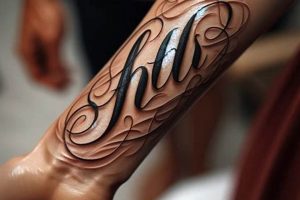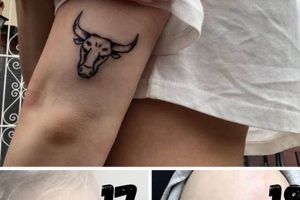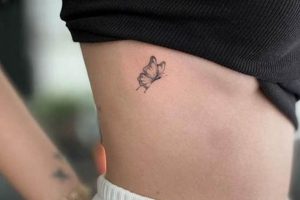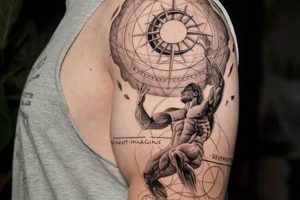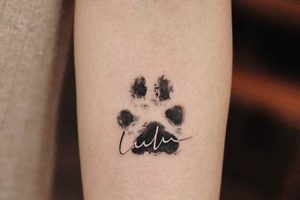Conceptualizing body art for the abdominal area involves considering both aesthetic and practical elements. This process often begins with researching various designs, styles, and artists specializing in this placement. For example, a potential design might involve a floral motif spanning the entire abdomen or a smaller, symbolic image placed discreetly near the navel.
The stomach offers a large, relatively flat canvas for intricate and expansive artwork. While it presents unique opportunities for self-expression, it’s important to acknowledge that the abdomen can be a sensitive area, and its flexibility means designs may distort with weight fluctuations or pregnancy. Historically, abdominal tattoos have held cultural significance in various societies, often representing personal narratives, beliefs, or group affiliations.
Key considerations for this placement include pain tolerance, design longevity, aftercare procedures, and finding a reputable artist experienced in abdominal tattoos. These factors will be explored in further detail below.
1. Placement
Placement is a crucial factor when considering abdominal tattoos. The stomach’s unique contours and flexibility present both opportunities and challenges for design choices. Strategic placement maximizes aesthetic impact while minimizing distortion due to body changes.
- Central Placement
Designs centered on the navel create a focal point and can be symmetrical or asymmetrical. Examples include mandalas, geometric patterns, or portraits. This placement suits designs intended to draw attention directly to the midsection. However, it’s essential to consider potential stretching with weight gain or pregnancy.
- Lower Abdominal Placement
Designs placed below the navel offer a discreet option and can complement the natural curves of the hips. Examples include floral patterns, script, or small symbolic images. This area generally experiences less stretching than the central abdomen.
- Upper Abdominal Placement
Designs situated above the navel, extending towards the ribcage, can create an elongated, flowing aesthetic. Examples include vines, abstract patterns, or animalistic imagery. This placement allows for larger designs but may be more susceptible to distortion from torso movement.
- Side Abdominal Placement
Designs positioned on the sides of the abdomen offer a unique and often less visible option. Examples include single elements like flowers or feathers, or continuous patterns that wrap around the body. This placement requires careful consideration of the body’s natural curvature and how the design will appear from different angles.
Ultimately, optimal placement depends on the individual’s anatomy, desired aesthetic, and the specific design. Consulting with a skilled tattoo artist experienced in abdominal tattoos is crucial for determining the most suitable placement to ensure a visually appealing and long-lasting result.
2. Size and Scale
Size and scale are critical considerations for stomach tattoos, impacting both aesthetic appeal and practical implications. The abdomen provides a relatively large canvas, allowing for diverse design choices. However, its dynamic nature necessitates careful planning regarding the artwork’s dimensions to ensure its integrity and visual appeal over time.
- Small-Scale Designs
Smaller tattoos offer subtlety and can be strategically placed to accentuate specific areas of the abdomen. Examples include minimalistic symbols, small floral designs, or short textual elements. These are ideal for individuals seeking a less conspicuous tattoo or testing their pain tolerance in this sensitive area. Smaller designs also tend to be less affected by changes in body shape.
- Large-Scale Designs
Larger designs allow for greater detail and complexity, encompassing intricate patterns, expansive scenes, or portraits. These pieces can create a dramatic statement and showcase artistic skill. However, larger designs require longer sessions and greater commitment due to increased pain and healing time. They are also more susceptible to distortion from weight fluctuations or pregnancy.
- Proportion and Body Shape
The chosen size and scale should complement the individual’s body shape and proportions. A large design might overwhelm a smaller frame, while a small design could get lost on a larger torso. The tattoo artist can advise on appropriate scaling to ensure the design harmonizes with the body’s natural contours.
- Long-Term Considerations
It’s crucial to consider how size and scale might be affected by future body changes. Weight fluctuations, pregnancy, and the natural aging process can all impact the appearance of a stomach tattoo. Discussing these factors with the artist can help determine a size and scale that maintains its integrity over time.
Choosing the appropriate size and scale is a collaborative process between the individual and the tattoo artist. Careful consideration of these factors ensures a visually harmonious and enduring piece of body art that complements the individual’s anatomy and personal style. Balancing aesthetic desires with the practical implications of placement on a dynamic body area like the stomach is paramount for long-term satisfaction.
3. Pain Management
Pain management is a crucial consideration for stomach tattoos due to the area’s heightened sensitivity. The thin skin and proximity to nerve endings contribute to increased discomfort during the tattooing process. Effective pain management strategies are essential for a comfortable experience and allow for longer sessions, particularly for larger or more intricate designs.
- Topical Anesthetics
Topical anesthetic creams and sprays containing lidocaine or prilocaine can numb the skin’s surface, reducing pain sensation during the procedure. These are typically applied prior to the tattooing process and may need reapplication during longer sessions. While effective, individual responses to topical anesthetics can vary, and some individuals may experience allergic reactions.
- Nerve Blocks
While less common for stomach tattoos, nerve blocks involve injecting an anesthetic directly into specific nerves to block pain signals. This technique provides more profound and longer-lasting pain relief than topical anesthetics. However, it requires a medical professional and carries potential risks, including nerve damage and infection.
- Breathing and Relaxation Techniques
Controlled breathing exercises and mindfulness techniques can help manage pain perception by reducing stress and anxiety. Deep, slow breaths can help regulate heart rate and distract from discomfort. Meditation or visualization can also be effective in managing pain during the tattooing process.
- Over-the-Counter Pain Relievers
Nonsteroidal anti-inflammatory drugs (NSAIDs) like ibuprofen can help reduce pain and inflammation before and after the tattoo session. However, it’s crucial to avoid aspirin or other blood-thinning medications before the procedure, as they can increase bleeding.
Effective pain management contributes significantly to a positive tattooing experience. By implementing appropriate strategies, individuals can tolerate longer sessions, allowing for more detailed and complex designs. Open communication with the tattoo artist about pain tolerance and preferred methods of pain management is essential for a comfortable and successful outcome. Choosing a reputable artist experienced in working on sensitive areas like the stomach is also vital, as they can offer guidance on appropriate techniques and aftercare procedures to minimize discomfort and promote healing.
4. Design Flexibility
Design flexibility is paramount for stomach tattoos due to the abdomen’s susceptibility to changes over time. Weight fluctuations, pregnancy, and the natural aging process can stretch or shrink the skin, potentially distorting the tattoo. Designs lacking inherent flexibility might become misshapen or lose their original clarity. Consider a detailed portrait tattooed on the abdomen; significant weight gain could stretch the image, altering facial features and overall composition. Conversely, weight loss could cause the skin to loosen, potentially resulting in a wrinkled or sagging appearance within the tattoo.
Incorporating flexibility into the design mitigates these risks. Flowing lines, geometric patterns, and strategically placed elements can accommodate changes in skin tension more effectively than rigid or highly detailed images. For example, a design featuring a series of interconnected swirling lines or a mandala-style pattern can adapt to stretching or shrinking without significant distortion. Similarly, incorporating negative space into the design allows for expansion and contraction without compromising the overall aesthetic. Choosing a skilled artist experienced in creating adaptable designs for this specific area is essential. They can advise on design choices that minimize the risk of distortion and maintain visual appeal despite body changes.
Understanding the dynamic nature of the abdomen and the potential impact on a tattoo’s appearance over time is crucial for making informed design decisions. Prioritizing design flexibility, considering the potential for future body changes, and collaborating with a skilled artist specializing in abdominal tattoos ensures a lasting and aesthetically pleasing result that adapts gracefully to the body’s transformations. Failure to address design flexibility can lead to dissatisfaction with the tattoo’s long-term appearance, highlighting the practical significance of incorporating this principle into the design process.
5. Artist Selection
Artist selection is paramount when considering a stomach tattoo. This area presents unique challenges due to its sensitivity, curvature, and propensity for change over time. A skilled artist specializing in abdominal tattoos possesses the expertise to address these challenges, ensuring both aesthetic appeal and longevity of the design. Their experience informs crucial decisions regarding placement, size, scale, and design flexibility, mitigating potential issues like distortion from weight fluctuations or pregnancy. For instance, an experienced artist understands how different needle depths and techniques affect the final result on the abdomen’s delicate skin, minimizing scarring and ensuring even ink saturation. They can also guide clients toward designs that complement the body’s natural contours and adapt to future changes, preserving the tattoo’s integrity over time.
Choosing an artist solely based on portfolio images without considering their experience with abdominal tattoos can lead to undesirable outcomes. A visually appealing design on a different body part doesn’t guarantee successful execution on the stomach. Artists specializing in this area possess a deep understanding of the anatomical nuances and potential challenges. They can anticipate how the design will age and adapt, offering valuable insights into design choices and placement strategies. Furthermore, a skilled artist prioritizes client communication, thoroughly discussing design concepts, potential risks, and aftercare procedures specific to abdominal tattoos. This collaborative approach ensures the client’s vision aligns with the artist’s expertise, leading to a more satisfying and successful outcome.
Ultimately, selecting a qualified and experienced artist specializing in abdominal tattoos significantly impacts the final result. Their expertise minimizes potential complications, ensures design longevity, and maximizes aesthetic appeal despite the abdomen’s dynamic nature. Thorough research, portfolio review focusing on abdominal work, and open communication are essential steps in finding an artist capable of translating a vision into a beautiful and enduring piece of body art. Prioritizing artist selection ensures the stomach tattoo remains a source of pride and satisfaction for years to come.
Tips for Stomach Tattoos
Careful planning is essential for successful stomach tattoos. These tips offer guidance for navigating the process, from design selection to aftercare.
Tip 1: Research Thoroughly
Extensive research is crucial before committing to a stomach tattoo. Explore various design styles, research experienced artists specializing in abdominal tattoos, and understand the healing process and potential risks associated with this placement. Reviewing healed photos of abdominal tattoos provides realistic expectations.
Tip 2: Prioritize Design Flexibility
Given the abdomen’s propensity for change, designs should accommodate potential stretching or shrinking. Opt for flowing lines, geometric patterns, or strategically placed elements that adapt to body fluctuations without significant distortion. Avoid overly intricate or rigid designs that may lose clarity with changes in skin tension.
Tip 3: Consult with Multiple Artists
Seek consultations with several artists specializing in abdominal tattoos. Discuss design ideas, placement options, and pain management strategies. Review their portfolios, focusing specifically on healed abdominal pieces to assess their skill and experience in this area. A thorough consultation process helps ensure a well-informed decision.
Tip 4: Prepare for the Pain
The abdomen is a sensitive area. Discuss pain management options with the chosen artist, including topical anesthetics, breathing techniques, and breaks during the session. Understanding the level of discomfort and preparing accordingly contributes to a more positive experience.
Tip 5: Follow Aftercare Instructions Diligently
Proper aftercare is critical for optimal healing and long-term tattoo health. Follow the artist’s specific instructions regarding cleaning, moisturizing, and protecting the tattoo. Avoid tight clothing or activities that could irritate the area during the healing process.
Tip 6: Consider Long-Term Implications
Recognize that body changes, such as weight fluctuations or pregnancy, can impact the tattoo’s appearance over time. Discuss these factors with the artist during the consultation to ensure the design remains aesthetically pleasing despite potential changes in body shape.
Tip 7: Budget Appropriately
High-quality abdominal tattoos require skilled artists and often multiple sessions, especially for larger designs. Factor in the cost of the tattoo, aftercare products, and potential touch-ups when budgeting for the procedure.
Careful consideration of these tips empowers informed decisions, leading to a successful and satisfying stomach tattoo experience. Proper planning, research, and artist selection are crucial for achieving a beautiful and enduring piece of body art.
By understanding the specific considerations and challenges associated with stomach tattoos, individuals can make informed choices that contribute to a positive experience and a lasting piece of art. This informed approach sets the stage for the next crucial phase: making the final decision and embarking on the tattooing journey.
Frequently Asked Questions
This section addresses common inquiries regarding abdominal tattoos, providing concise and informative responses to facilitate informed decision-making.
Question 1: How much do stomach tattoos typically cost?
Pricing varies based on factors such as design complexity, size, artist experience, and geographic location. Larger, more intricate designs require longer sessions, impacting overall cost. Researching local artists and requesting quotes provides a clearer understanding of expected expenses.
Question 2: How long does a stomach tattoo take to heal?
Healing time typically ranges from two to four weeks, depending on individual factors such as overall health and adherence to aftercare instructions. Larger pieces may require a longer healing period. Complete healing, including internal tissue regeneration, can take several months.
Question 3: Are stomach tattoos more painful than tattoos on other body parts?
The abdomen is considered a more sensitive area due to thin skin and proximity to nerve endings. Pain tolerance varies among individuals, but generally, stomach tattoos tend to be more painful than tattoos on areas with more muscle or fat.
Question 4: How will a stomach tattoo be affected by pregnancy?
Pregnancy-induced skin stretching can distort the tattoo’s appearance. The degree of distortion depends on the extent of stretching and the design’s flexibility. While some changes are inevitable, choosing adaptable designs and optimal placement can minimize distortion. Consulting with an experienced artist specializing in abdominal tattoos is crucial to address these concerns.
Question 5: Can I get a stomach tattoo if I’m overweight?
Weight isn’t necessarily a barrier to getting a stomach tattoo. However, significant weight fluctuations can impact the design’s appearance over time. An experienced artist can advise on suitable placement and design choices that minimize potential distortion from weight changes.
Question 6: How do I find a reputable tattoo artist for a stomach tattoo?
Thorough research is crucial for selecting a qualified artist. Look for artists specializing in abdominal tattoos, review their portfolios focusing on healed abdominal pieces, and seek recommendations from trusted sources. Consultations with multiple artists allow for comparison of styles, expertise, and approaches to addressing the specific challenges of abdominal tattoos.
Addressing these common questions provides a foundational understanding of the key considerations associated with stomach tattoos. Further exploration of individual circumstances and preferences is encouraged for well-informed decisions.
The next section explores specific design ideas and motifs suitable for stomach tattoos, catering to diverse aesthetic preferences and personal narratives.
Conclusion
Careful consideration of placement, size and scale, pain management, design flexibility, and artist selection are paramount for successful abdominal tattoos. This body area presents unique opportunities and challenges due to its sensitivity, curvature, and propensity for change. Prioritizing design flexibility and choosing a skilled artist specializing in this placement minimizes potential complications and ensures the tattoo’s aesthetic longevity despite body fluctuations over time. Thorough research, consultations, and realistic expectations contribute to a positive experience and a lasting piece of body art.
Abdominal tattoos offer a powerful canvas for self-expression, allowing individuals to showcase personal narratives, beliefs, or artistic preferences. A well-planned and executed abdominal tattoo becomes an enduring embodiment of personal style and a testament to the collaborative artistry between the individual and a skilled tattooist. Ultimately, understanding the specific considerations outlined herein empowers informed decisions, transforming the concept of “tattoo ideas stomach” into a tangible, personalized reality.


